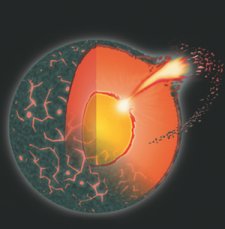
Posted on Sunday, December 14 2008 @ 15:10 CET by Thomas De Maesschalck
Retired nuclear geophysicist Rob de Meijer and petrologist Wim van Westrenen from the Free University in Amsterdam propose a controversial new theory to explain how the Moon formed. The Dutch geophysicists believes the Moon may have been created by a runaway nuclear reaction deep inside the young Earth 4.5 billion years ago, and not by an impact of a primordial celestial body the size of Mars.
In his renovated Saxon farmhouse in Peize in the north of the Netherlands, retired nuclear geophysicist Rob de Meijer vividly paints a picture of the cataclysm: "The material in the Earth's mantle heated up some 8,000ºC and was completely vaporised.
This huge bubble of gas forced itself up through the still liquid mantle," he says. "As a result, part of the Earth's mantle and crust were blown away, as well as the early atmosphere. From the debris, the Moon could have formed rather quickly."
The Earth ejecting the Moon: isn't that a rather fanciful scenario? Not according to de Meijer and his colleague, petrologist Wim van Westrenen from the Free University in Amsterdam. They argue that this hypothesis is the logical consequence of new data, and also that an erupting Earth solves a number of unsolved and profound astronomical mysteries.
You can read more about the theory
at COSMOS magazine.
